Unit 9 翻译中视角的转移
- 格式:ppt
- 大小:221.50 KB
- 文档页数:22



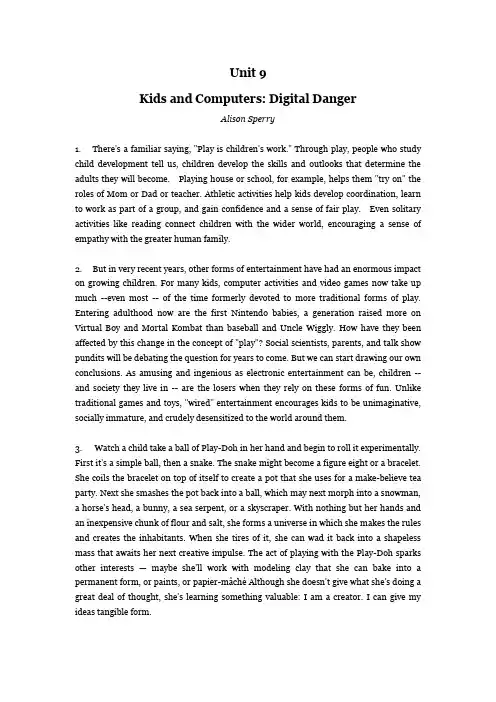
Unit 9Kids and Computers: Digital DangerAlison Sperry1. There's a familiar saying, "Play is children's work." Through play, people who study child development tell us, children develop the skills and outlooks that determine the adults they will become. Playing house or school, for example, helps them "try on" the roles of Mom or Dad or teacher. Athletic activities help kids develop coordination, learn to work as part of a group, and gain confidence and a sense of fair play. Even solitary activities like reading connect children with the wider world, encouraging a sense of empathy with the greater human family.2. But in very recent years, other forms of entertainment have had an enormous impact on growing children. For many kids, computer activities and video games now take up much --even most -- of the time formerly devoted to more traditional forms of play. Entering adulthood now are the first Nintendo babies, a generation raised more on Virtual Boy and Mortal Kombat than baseball and Uncle Wiggly. How have they been affected by this change in the concept of "play"? Social scientists, parents, and talk show pundits will be debating the question for years to come. But we can start drawing our own conclusions. As amusing and ingenious as electronic entertainment can be, children -- and society they live in -- are the losers when they rely on these forms of fun. Unlike traditional games and toys, "wired" entertainment encourages kids to be unimaginative, socially immature, and crudely desensitized to the world around them.3. Watch a child take a ball of Play-Doh in her hand and begin to roll it experimentally. First it's a simple ball, then a snake. The snake might become a figure eight or a bracelet. She coils the bracelet on top of itself to create a pot that she uses for a make-believe tea party. Next she smashes the pot back into a ball, which may next morph into a snowman, a horse's head, a bunny, a sea serpent, or a skyscraper. With nothing but her hands and an inexpensive chunk of flour and salt, she forms a universe in which she makes the rules and creates the inhabitants. When she tires of it, she can wad it back into a shapeless mass that awaits her next creative impulse. The act of playing with the Play-Doh sparks other interests —maybe she'll work with modeling clay that she can bake into a permanent form, or paints, or papier-mâché Although she doesn't give what she's doing a great deal of thought, she's learning something valuable: I am a creator. I can give my ideas tangible form.4. A video game, on the other hand, is cynically programmed to give the illusion of creativity. The player is given various choices at every turn —Which door will I go through? Which weapon will I use? What clue shall I read? — But they are choices in the same sense that a pigeon's pecking at a lever to get a grain of corn is a choice. The player is as much a tool of the game as the joystick. Her momentary fun is unsatisfying because it leads not to any genuine sense of achievement but only to the hypnotic experience of watching someone else's creation unfold. Hand a ball of Play-Doh to a child reared on the sterile adventure of video games, and you're apt to get a blank look and the hesitant question, "What do I do with it?" The video game player learns her own lesson: I don't create. I let someone else's creativity happen in front of me.5. It's a beautiful Saturday in autumn, and a group of kids are playing a pickup game of soccer. A dispute arises about whether a kick went over the foul line. Some of the kids are sure it did; others insist that it did not. Voices are raised; tempers flare. Maybe a hothead or two will stalk off the field. But the sky is crystal blue, and there are chores waiting at home. Making a quick calculation about the relative benefits of continuing the game, the players work out a solution. Maybe they replay the kick. Maybe they flip a coin. Maybe they agree to say that the ball was fair, or foul. Their willingness to compromise, to accept the idea that such give-and-take is part of life, allows the game to proceed. The players move on, having learned a small lesson about getting along with others.6. Contrast that scene with the world of the Internet chat rooms, where many adolescents spend uncountable hours. On that same lovely Saturday, a young Internet queen hunches over her keyboard, alone in her room. Her buddy list includes dozens, even scores, of "friends" she's never met. Her fingers fly across the keyboard as she races from one dialogue box to another, keeping up multiple conversations. These are peculiar conversations, however, including none of the vulnerability that is part of real-world friendship. In the buddy-chat world, status is based on the ability to keep up a rapid pace of one-liners, insulting zingers, caustic put-downs. The chat queen's most intimate friendships take the form of brief alliances with buddies who join with her to "flame" another chatter who has displeased them. If that ally eventually becomes annoying, too, zap! She can instantaneously erase him from her buddy list, or even block him so he is unable to contact her again. It's no great loss. There are literally millions of new acquaintances waiting to be picked up in a chat room to fill that void. The lesson: I shouldn't have to work at relationships. They come and go instantly and at my convenience. If someone displeases me, I can make that person disappear.7. When kids sit down to play Monopoly, they form a loosely knit group that is still part of the world around it. When company arrives at the house, it's no problem to halt thegame briefly. The players can greet visitors, laugh together, talk about the game, even quickly rearrange it to include new players. Even after the game continues, chatting with other players and non-players is easily accomplished. Despite their involvement in the game, the players are not ruled by it. Human contact, courtesy, and communication are not seen as threats to their enjoyment. They are learning that they can enjoy their own activities and still be sensitive to the larger world around them.8. Contrast this board game scene with one that has become depressingly familiar in many living rooms. Visitors arrive at a home to find a child hunched in front of the TV set, video controls in his lap. Even when spoken to directly, he does not pull his eyes from the screen. "I'm playing!" is his furious response if the visitors persist in trying to engage his attention. Far too often, even his parents, intimidated by the high-priced, high-tech gadget that has sucked their child's humanity away, tiptoe around rather than disturb him. The game itself is all too likely to be one that presents the most hideous suffering as entertainment, with the player in the role of psychotic killer -- maybe in Duke Nukem, with its "twenty-three levels of nonstop carnage!" or Bloody Roar, which offers the player "more ways to maim, crush, and devour your enemies than ever."9. The lesson?10. Isn't it too awful to think about?1. 有一句众人皆知的俗语:“玩是孩子们的工作。
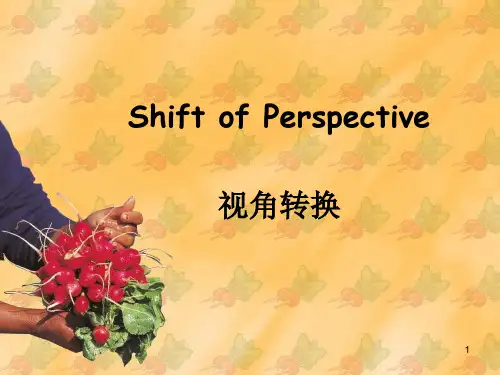
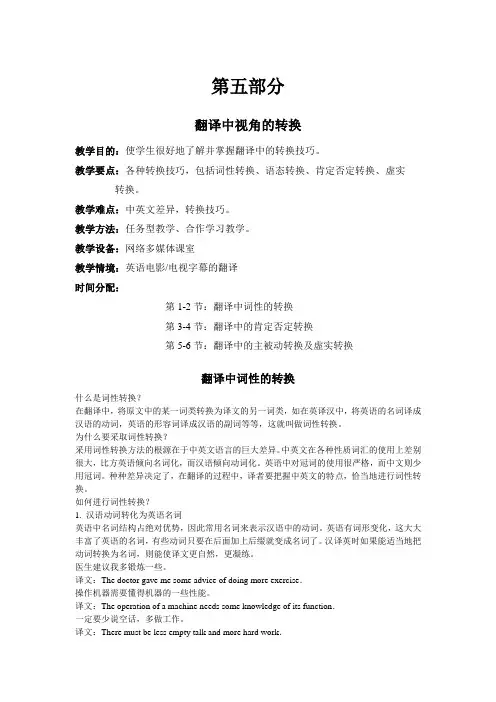
第五部分翻译中视角的转换教学目的:使学生很好地了解并掌握翻译中的转换技巧。
教学要点:各种转换技巧,包括词性转换、语态转换、肯定否定转换、虚实转换。
教学难点:中英文差异,转换技巧。
教学方法:任务型教学、合作学习教学。
教学设备:网络多媒体课室教学情境:英语电影/电视字幕的翻译时间分配:第1-2节:翻译中词性的转换第3-4节:翻译中的肯定否定转换第5-6节:翻译中的主被动转换及虚实转换翻译中词性的转换什么是词性转换?在翻译中,将原文中的某一词类转换为译文的另一词类,如在英译汉中,将英语的名词译成汉语的动词,英语的形容词译成汉语的副词等等,这就叫做词性转换。
为什么要采取词性转换?采用词性转换方法的根源在于中英文语言的巨大差异。
中英文在各种性质词汇的使用上差别很大,比方英语倾向名词化,而汉语倾向动词化。
英语中对冠词的使用很严格,而中文则少用冠词。
种种差异决定了,在翻译的过程中,译者要把握中英文的特点,恰当地进行词性转换。
如何进行词性转换?1. 汉语动词转化为英语名词英语中名词结构占绝对优势,因此常用名词来表示汉语中的动词。
英语有词形变化,这大大丰富了英语的名词,有些动词只要在后面加上后缀就变成名词了。
汉译英时如果能适当地把动词转换为名词,则能使译文更自然,更凝练。
医生建议我多锻炼一些。
译文:The doctor gave me some advice of doing more exercise.操作机器需要懂得机器的一些性能。
译文:The operation of a machine needs some knowledge of its function.一定要少说空话,多做工作。
译文:There must be less empty talk and more hard work.人口在不断地增加。
译文:There is a steady increase in population.2.汉语动词译为英语介词或介词短语英语中介词数量多,搭配灵活,意义丰富。
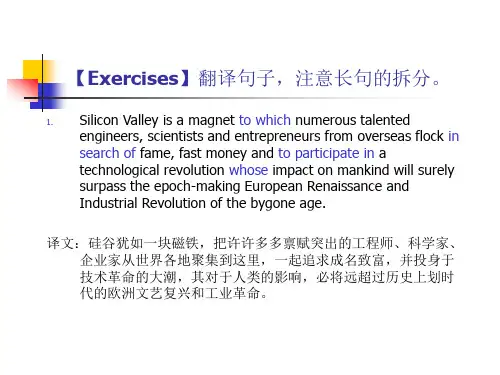
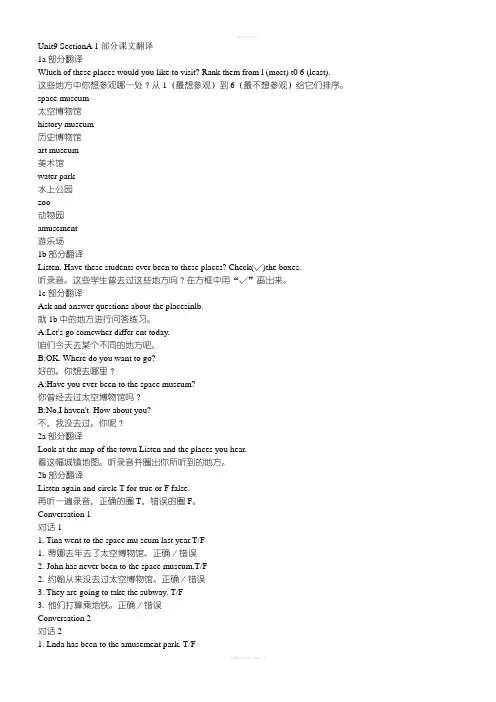
Unit9 SectionA 1部分课文翻译1a部分翻译Wluch of these places would you like to visit? Rank them from l (most) t0 6 (least).这些地方中你想参观哪一处?从1(最想参观)到6(最不想参观)给它们排序。
space museum_____太空博物馆_____history museum_____历史博物馆_____art museum_____美术馆_____water park_____水上公园_____zoo_____动物园_____amusement_____游乐场_____1b部分翻译Listen. Have these students ever been to these places? Check(√)the boxes.听录音。
这些学生曾去过这些地方吗?在方框中用“√”画出来。
1c部分翻译Ask and answer questions about the placesinlb.就1b中的地方进行问答练习。
A:Let's go somewher differ ent today.咱们今天去某个不同的地方吧。
B:OK. Where do you want to go?好的。
你想去哪里?A:Have you ever been to the space museum?你曾经去过太空博物馆吗?B:No,I haven't. How about you?不,我没去过。
你呢?2a部分翻译Look at the map of the town Listen and the places you hear.看这幅城镇地图。
听录音并圈出你所听到的地方。
2b部分翻译Listen again and circle T for true or F false.再听一遍录音,正确的圈T,错误的圈F。
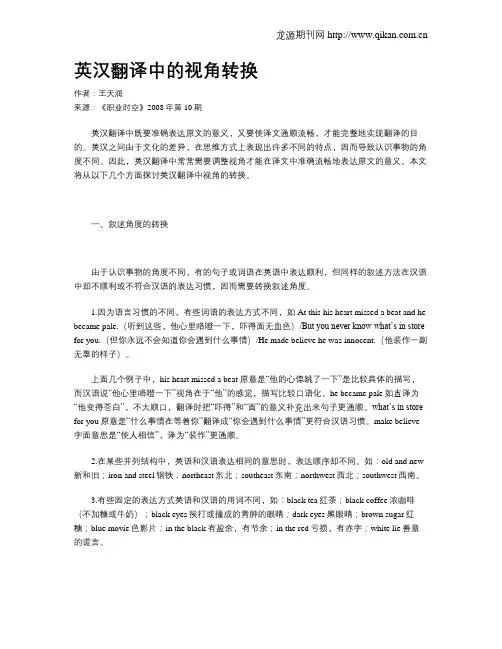
英汉翻译中的视角转换作者:王天润来源:《职业时空》2008年第10期英汉翻译中既要准确表达原文的意义,又要使译文通顺流畅,才能完整地实现翻译的目的。
英汉之间由于文化的差异,在思维方式上表现出许多不同的特点,因而导致认识事物的角度不同。
因此,英汉翻译中常常需要调整视角才能在译文中准确流畅地表达原文的意义。
本文将从以下几个方面探讨英汉翻译中视角的转换。
一、叙述角度的转换由于认识事物的角度不同,有的句子或词语在英语中表达顺利,但同样的叙述方法在汉语中却不顺利或不符合汉语的表达习惯,因而需要转换叙述角度。
1.因为语言习惯的不同,有些词语的表达方式不同,如At this his heart missed a beat and he became pale.(听到这些,他心里咯噔一下,吓得面无血色)/But you never know what’s in store for you.(但你永远不会知道你会遇到什么事情)/He made believe he was innocent.(他装作一副无辜的样子)。
上面几个例子中,his heart missed a beat 原意是“他的心停跳了一下”是比较具体的描写,而汉语说“他心里咯噔一下”视角在于“他”的感觉,描写比较口语化。
he became pale如直译为“他变得苍白”,不太顺口,翻译时把“吓得”和“面”的意义补充出来句子更通顺。
what’s in store for you原意是“什么事情在等着你”翻译成“你会遇到什么事情”更符合汉语习惯。
make believe 字面意思是“使人相信”,译为“装作”更通顺。
2.在某些并列结构中,英语和汉语表达相同的意思时,表达顺序却不同。
如:old and new 新和旧;iron and steel钢铁;northeast东北;southeast东南;northwest西北;southwest西南。
3.有些固定的表达方式英语和汉语的用词不同,如:black tea红茶;black coffee浓咖啡(不加糖或牛奶);black eyes挨打或撞成的青肿的眼睛;dark eyes黑眼睛;brown sugar红糖;blue movie色影片;in the black有盈余,有节余;in the red亏损,有赤字;white lie善意的谎言。

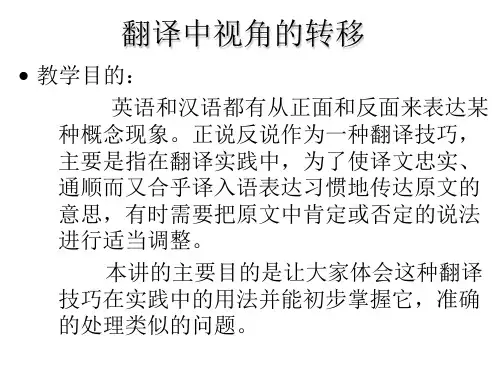
Unit 9 What Is Happiness?The right to pursue happiness is issued to Americans with their birth certificates, but no one seems quite sure which way it runs. It may be we are issued a hunting license but offered no game. Jonathan Swift seemed to think so w hen he attacked the idea of happiness as “the possession of being well-deceived,” the felicity of being “a fool among knaves.” For Swift saw society as Vanity Fair, the land of false goals.自从呱呱坠地,美国人就被赋予了追求幸福的权利,但似乎没人确信幸福究竟在哪里。
正如它发给我们狩猎证,却不给我们提供猎物。
乔纳森•斯威福特似乎持此观点,他抨击幸福的想法是“鬼迷心窍的上当,”是“骗子堆中的傻瓜”的自鸣得意。
因为他视社会为虚妄目标聚集的名利场。
It is, of course, un-American to think in terms of fools and knaves. We do, however, seem to be dedicated to the idea of buying our way to happiness. We shall all have made it to Heaven when we possess enough.当然用傻子、骗子这样的字眼来形容是不合美国的人的风俗习惯的,然后我们似乎确实沉溺于用金钱购买幸福的想法:只要有足够的钱,我们百年后就能上天堂。
补充材料:英汉、汉英翻译技巧:视角转换(Shift of Perspective)E-C.1. The University of San Francisco is located near the Golden Gate Park.(语态的转换)2. Her parents are both in their seventies.(表达方式的转换)3. If children are so well able to learn their mother tongue, it is precisely because they plunge themselves into the sea of language instead of reading a few textbooks only. (条件状语转换成结果状语)4. You can mass-produce … incredible quantities of facts and figures. You cannot mass-produce knowledge, which is created by individual minds, drawing on individual experience, separating the significant from the irrelevant.(定语从句转换成原因状语从句)5. "Coming!" Away she skimmed over the lawn, up the path, up the steps, across the verandah, and into the porch.(介词转换成动词)6. Highway and air traffic came to a standstill in most of Eastern Washington.(名词转换成动词)7. I believe equally that it is in the interests of the world as a whole that Europe should increasingly unite and speak with a common voice.(词序调整)8. Little did I then know the meaning of war and what it was in reality.(词序调整)9. It is a good workman that never blunders.(反说正译)10. Keep off the lawn!11.That fellow is far from being honest.12.Obviously enough, she thinks otherwise.(正说反译)13 I was like that ship before education began, only I was without compass or sounding-line, and had no way of knowing how near the harbor was.汉译:我在开始受教育之前,就像这样一条船,只是没有罗盘,没有测深绳,也无法知道离海港有多远。
英汉翻译中视角的转换类型及处理方式[ 08-11-09 10:56:00 ] 作者:彭雅琼编辑:studa0714【摘要】受制于英汉双语在结构及习惯表达上的差异性,在英汉翻译中运用视角转换的方法,可以使译文通顺流畅,符合译语读者的语言习惯。
本文主要分析了正说反译、形象转换、虚实转换以及为了达到修辞目的的转换办法,说明视角转换的翻译方法对于增强译文的可读性有很大作用。
【关键词】英汉翻译;视角转换作为一种双语艺术,翻译是从一种语言到另一种语言的转换。
二十世纪六十年代,奈达提出的形式对应翻译基本上以原语为中心,力求使接受语中的信息尽可能地接近原语中的各种成分,最大限度的显示原文中的形式和内容,努力再现多种形式因素。
然而,翻译并不是从一种语言到另一种语言词和词的单纯转换。
由于任何一种语言都局限于自己特定的文化背景中,它们各自在其渊远流长的历史中形成了独有的表达方式。
同时,使用不同语言的读者也形成了对自己所属语言系统独特的表达方式的习惯性。
因此,相同的思维内容可以用不同的语言负载,这并不意味着原语和译语间在形式和语境上有完全相同的意义。
纽马克提出,在译入语允许的范围内,尽可能地使译文从语义和句法上接近原文,将原文确切的上下文意义翻译出来,进行“语义翻译”。
各语言的表现形式上存在纷繁复杂的差异性,这就要求译者在不涉及特殊文化背景因素的情况下,用译语意义代替原语意义,“重组原语信息的表现形式,从与原语不同甚或相反的角度来传达同样的信息”(柯平,1995),这就是所谓的视角转换。
这种翻译方法使得译文更符合译语习惯,同时也更好地传达原作信息。
一、正反转换(Negation)正反转换是最主要的视角转换类型之一,意即对那些正面译不通顺的英语表达从反面来译,从反面译不通顺的从正面来译,出于对译语优势、可接受性和可读性方面的考虑,而舍弃形式方面的意义对等,保留内容方面的意义对等。
①He manifested a strong dislike for his father’s business.他对他父亲的行业表示强烈的厌恶情绪。